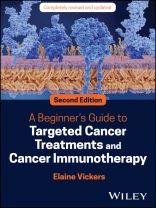Demystifying the science behind new cancer treatments
A clear and accessible guide written in everyday language for nurses and other healthcare professionals
A Beginner’s Guide to Targeted Cancer Treatments and Cancer Immunotherapy helps readers understand the science behind many of the newer drug treatments for cancer. Assuming only a basic familiarity with cell biology, this easy-to-digest guide describes how our increased understanding of cancer has been translated into the creation of new cancer treatments with a wide range of targets.
Gifted communicator and educator Dr. Elaine Vickers helps you understand the mechanisms of a wide range of individual targeted therapies and immunotherapies — enabling you to communicate effectively with your colleagues and patients. Concise chapters explain how new cancer drugs and immunotherapies work, discuss their benefits, identify their limitations, and more.
Now in its second edition, this popular handbook is fully revised to reflect the latest developments in targeted drug therapies and immunotherapies. Entirely new chapters on advancements in various immunotherapies are accompanied by more than 100 new and updated color illustrations.
- Provides an up-to-date overview of relevant treatment targets for all major cancer types, including hematological cancers
- Describes cancer biology and the relationship between cancer and the immune system
- Offers valuable insights into cell communication pathways as a common target
- Covers small molecule drugs, antibody-based treatments, and cellular therapies, including novel immunotherapies
A Beginner’s Guide to Targeted Cancer Treatments and Cancer Immunotherapy is a must-have resource for trainees, practicing nurses, and other healthcare professionals involved in the care of cancer patients, as well as non-specialists who encounter cancer data or cancer terminology in their field.
Spis treści
Acknowledgments ix
Praise for the First Edition xi
About the Author xiii
How to Use This Book xv
Chapter 1 An Introduction to Cancer Cell Biology and Genetics 1
1.1 Introduction 2
1.2 DNA Damage Is the Cause of Every Cancer 3
1.3 The Defining Features (Hallmarks) of Cancer Cells 18
1.4 Variation Among Cancer Cells in a Single Tumor 20
1.5 Cancer’s Relationship with Our Immune System 22
1.6 The Cancer Microenvironment 30
1.7 Cancer Spread/Metastasis 36
1.8 Cancer Stem Cells 39
1.9 Unique Properties of Hematological Cancers 40
1.10 Obstacles that Prevent Us from Curing Cancer 46
1.11 Final Thoughts 52
Chapter 2 Monoclonal Antibodies and Small Molecules as Cancer Treatments, 61
2.1 Introduction 62
2.2 Antibody-Based Cancer Treatments 66
2.3 Small Molecule Cancer Treatments 83
2.4 Treatment Combinations 99
2.5 Final Thoughts 100
Chapter 3 Treatments that Target Cell Communication 109
3.1 Introduction 110
3.2 Growth Factor-Controlled Signaling Pathways 112
3.3 Growth Factor Receptors in Cancer 118
3.4 Drugs that Target EGFR 121
3.5 Drugs that Target HER2 131
3.6 Drugs that Block Other Growth Factor Receptors 138
3.7 Targeting the MAPK Signaling Pathway 145
3.8 Targeting the PI3K/AKT/m TOR Signaling Pathway 156
3.9 Targeting the JAK-STAT Pathway 164
3.10 Bcr-Abl Inhibitors 167
3.11 Final Thoughts 169
Chapter 4 More Targets and Treatments 183
4.1 Angiogenesis Inhibitors 184
4.2 Antibody Conjugates 195
4.3 PARP Inhibitors 202
4.4 CDK Inhibitors and Other Cell Cycle-Targeted Treatments 211
4.5 Hedgehog Pathway Inhibitors 219
4.6 Targeting Epigenetic Enzymes 222
4.7 Targeting Cell Survival 226
4.8 Targeting B Cell Receptor Signaling 230
4.9 Nuclear Transport Inhibitors 235
4.10 Proteasome Inhibitors 236
4.11 Final Thoughts 240
Chapter 5 Immunotherapy with Checkpoint Inhibitors, 253
5.1 The Importance of T Cells 254
5.2 An Introduction to Immune Checkpoint Inhibitors 256
5.3 How Checkpoint Inhibitors Work 260
5.4 Lessons Learned from Checkpoint Inhibitor Trials 261
5.5 Why Some Patients Benefit from Checkpoint Inhibitors and Others Don’t 271
5.6 Biomarkers of Response to Checkpoint Inhibitors 275
5.7 Checkpoint Inhibitor Combinations 282
5.8 Novel Checkpoint Inhibitors and Activators 287
5.9 Final Thoughts 290
Chapter 6 Other Forms of Immunotherapy 301
6.1 Introduction 302
6.2 Naked Antibodies that Trigger an Immune Response 303
6.3 Immunomodulators and CELMo Ds 304
6.4 Introduction to Adoptive Cell Therapies 307
6.5 Tumor‐Infiltrating Lymphocyte Therapy 308
6.6 CAR T Cell Therapy 312
6.7 TCR‐Engineered T Cell Therapy 326
6.8 Cell Therapy with Other White Blood Cells 331
6.9 T Cell Engagers 332
6.10 Cancer Treatment Vaccines 340
6.11 Final Thoughts 351
Chapter 7 Treatments Relevant to Individual Cancer Types 359
7.1 Introduction 359
7.2 Treatments for Breast Cancer 361
7.3 Treatments for Bowel and Anal Cancers 364
7.4 Treatments for Lung Cancer 367
7.5 Treatments for Prostate, Testicular, and Penile Cancers 371
7.6 Treatments for Head and Neck Cancer 374
7.7 Treatments for Esophageal, Gastroesophageal Junction, and Stomach Cancers 376
7.8 Treatments for Pancreatic, Bile Duct, and Primary Liver Cancers 378
7.9 Treatments for Kidney and Bladder Cancers 381
7.10 Treatments for Ovarian Cancer 383
7.11 Treatments for Other Gynaecological Cancers 384
7.12 Treatments for Brain and CNS Cancers 386
7.13 Treatments for Skin Cancer 388
7.14 Treatments for B Cell and T Cell Leukemias 391
7.15 Treatments for Non-Hodgkin Lymphomas 393
7.16 Treatments for Hodgkin Lymphoma and Myeloma 395
7.17 Treatments for Myeloid Cell Cancers 397
7.18 Treatments for Childhood Cancers 400
Appendix 411
Glossary of Terms 413
Index 431
O autorze
DR. ELAINE VICKERS is the founder of Science Communicated Ltd, an independent company that provides in-person and online education on cancer biology, targeted cancer treatments, and cancer immunotherapies. In partnership with numerous hospitals, institutes, charities, companies, and clinical trials units, Dr. Vickers educates hundreds of healthcare professionals each year. She holds a degree in Medical Science from the University of Birmingham and a Ph D in Molecular Biology from the University of Manchester.












